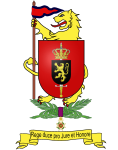Autoworld (museum)
AC with 0 elementsAutomotive museumsBelgian building and structure stubsCinquantenaireEuropean museum stubs ... and 1 more
Museums in Brussels

Autoworld is a museum of vintage cars in Brussels, Belgium. It is located in the southern hall of the Cinquantenaire Park, and displays a large and varied collection of over 250 European and American automobiles from the late 19th century to the 1990s. It is notable for its collections of early and Belgian-produced vehicles, including Minervas and several limousines belonging to the Belgian royal family.
Excerpt from the Wikipedia article Autoworld (museum) (License: CC BY-SA 3.0, Authors, Images).Autoworld (museum)
Porte de Tervueren - Tervuursepoort,
Geographical coordinates (GPS) Address Nearby Places Show on map
Geographical coordinates (GPS)
| Latitude | Longitude |
|---|---|
| N 50.840555555556 ° | E 4.3927777777778 ° |
Address
Tunnel Cinquantennaire - Eeuwfeesttunnel
Porte de Tervueren - Tervuursepoort
1040
Belgium
Open on Google Maps








